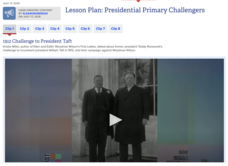C-SPAN
Presidential Primary Challengers
A formidable opponent can shake up the election of an incumbent president. Class members explore the results of the elections of 1912, 1968, 1976, 1980 and 1992 using video clips. A chart helps pupils organize their thoughts and...
C-SPAN
How A Bill Becomes A Law
Seven steps are required for a bill to become a United States law. The Families First Coronavirus Response Act (H.R. 6201) is used as a model for the process of how a bill becomes a law. Class members work independently through a...
C-SPAN
The Role of the Executive Branch in Policy Making
Although the president of the United States does not have the power to pass laws, they can propose legislation, veto bills passed by Congress, and issue executive orders that bypass Congress. Six video clips show middle schoolers these...
C-SPAN
Presidential Veto and Congressional Override
One of the key powers of the executive branch is the president's ability to pass or veto legislation proposed by Congress. Congress, the legislative branch, on the other hand, can override a president's veto. Five film clips show how the...
iCivics
Executive Command
What is it like to be the commander in chief? Learners find out using an engaging video game simulation. As they juggle diplomacy and bills sent from Congress, they make choices to push forward an agenda on issues they think are...
iCivics
Mini-Lesson: Veto Power
No means no! Scholars analyze the impact of one of the president's most powerful tools—the veto—while also finding out ways to properly check facts for validity. They research the power of the presidential veto with paired activities and...
Curated OER
Whose go the Power: Checks and Balances
After introducing the three branches of US government, test the class' understanding of government powers. They are asked a series of questions regarding a federal act and then, answer which branch has the power of decision making....
Curated OER
The Role of the Executive Branch in the Lawmaking Process
Students examine Article I, Section 7, and Article II, Sections 2 and 3, of the U.S. Constitution, explain the president's role in the lawmaking process, and define the term veto.
Curated OER
All Those In Favor
Students share opinions about measures recently passed in their school, vote on and argue for and against hypothetical school policies, and respond to a "president's" decision to pass or veto the measures.
Curated OER
Reconstruction: "Healing Wounds, Mending Fences"
Students examine material on the Civil War Era to develop an understanding of the major issues that were resolved. This six lessons unit provides a closer glimpse into our nation's political and ethical history.
Curated OER
Ports in the Storm
Students explore national security issues related to the possibility of a Dubai-owned company operating an American port. Opinions are solicited and debated.












